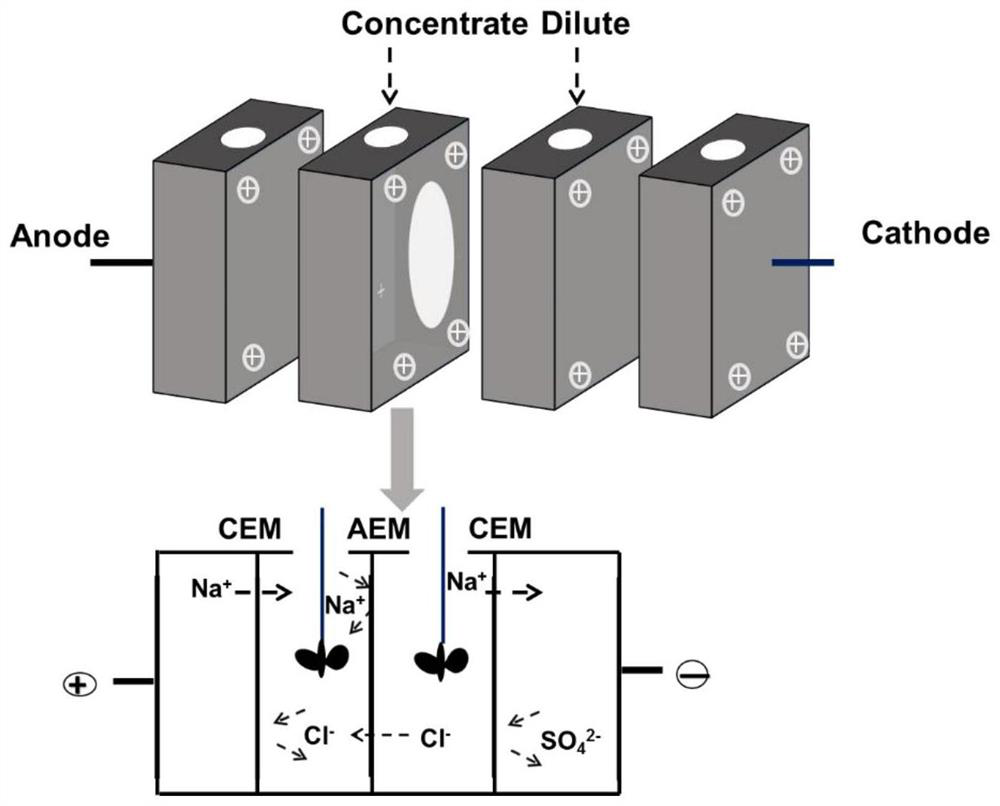Preparation and Application of an Anion Exchange Membrane Using BMP for Internal Crosslinking
An anion exchange membrane and electrodialysis technology, which is applied in the field of preparation and application of anion exchange membranes using BMP for internal cross-linking, can solve the problems of poor mechanical properties and dimensional stability, poor performance, complicated processes, etc. The effect of alkali resistance and swelling resistance, high current efficiency, high salt rejection rate
- Summary
- Abstract
- Description
- Claims
- Application Information
AI Technical Summary
Problems solved by technology
Method used
Image
Examples
preparation example Construction
[0029] Preparation of chloromethylated polysulfone (CMPSF):
[0030] Pour 10g of polysulfone (PSF) into a three-necked flask, then add 500mL of chloroform, stir for 12h to dissolve completely, then add 13.56g of paraformaldehyde, 57.36mL of trimethylchlorosilane and 0.53mL of tetra Add tin chloride to the above solution in turn, heat and stir for 60h, and set the temperature to 50 o c. Finally, the solution was precipitated in ethanol solution to precipitate the product, and then the product was suction-filtered and dried to obtain chloromethylated polysulfone (CMPSF).
Embodiment 1
[0032] Accurately weighed 0.5 g of chloromethylated polysulfone into 7 mL of 1-methyl-2-pyrrolidone (NMP), stirred and dissolved at room temperature for 5 h, and dissolved it completely to obtain a colorless transparent solution. Add 0.052 g of 4,4'-trimethylenebis(1-methylpiperidine) (BMP) to the resulting solution, and then stir the reaction at room temperature for 1 h to allow cross-linking and quaternization reactions to occur, and then The casting solution was degassed in a vacuum oven. Finally, pour the casting solution on a clean glass plate and scrape the film with a scraper, and dry it in vacuum at 80°C for 24 h. Take out the dried membrane, soak it in deionized water, let it fall off freely, and use it for future use (recorded as CAPSF-40 membrane).
Embodiment 2
[0034] Accurately weighed 0.5 g of chloromethylated polysulfone into 7 mL of 1-methyl-2-pyrrolidone (NMP), stirred and dissolved at room temperature for 5 h, and dissolved it completely to obtain a colorless transparent solution. Add 0.078 g of 4,4'-trimethylenebis(1-methylpiperidine) (BMP) to the resulting solution, and then stir the reaction at room temperature for 50 min to allow cross-linking and quaternization reactions to occur, and then The casting solution was degassed in a vacuum oven. Finally, pour the casting solution on a clean glass plate and scrape the film with a scraper, and dry it in vacuum at 80 °C for 24 h. Take out the dried membrane, soak it in deionized water, let it fall off freely, and use it for future use (denoted as CAPSF-60 membrane).
PUM
| Property | Measurement | Unit |
|---|---|---|
| area | aaaaa | aaaaa |
| area | aaaaa | aaaaa |
Abstract
Description
Claims
Application Information
 Login to View More
Login to View More - R&D
- Intellectual Property
- Life Sciences
- Materials
- Tech Scout
- Unparalleled Data Quality
- Higher Quality Content
- 60% Fewer Hallucinations
Browse by: Latest US Patents, China's latest patents, Technical Efficacy Thesaurus, Application Domain, Technology Topic, Popular Technical Reports.
© 2025 PatSnap. All rights reserved.Legal|Privacy policy|Modern Slavery Act Transparency Statement|Sitemap|About US| Contact US: help@patsnap.com



